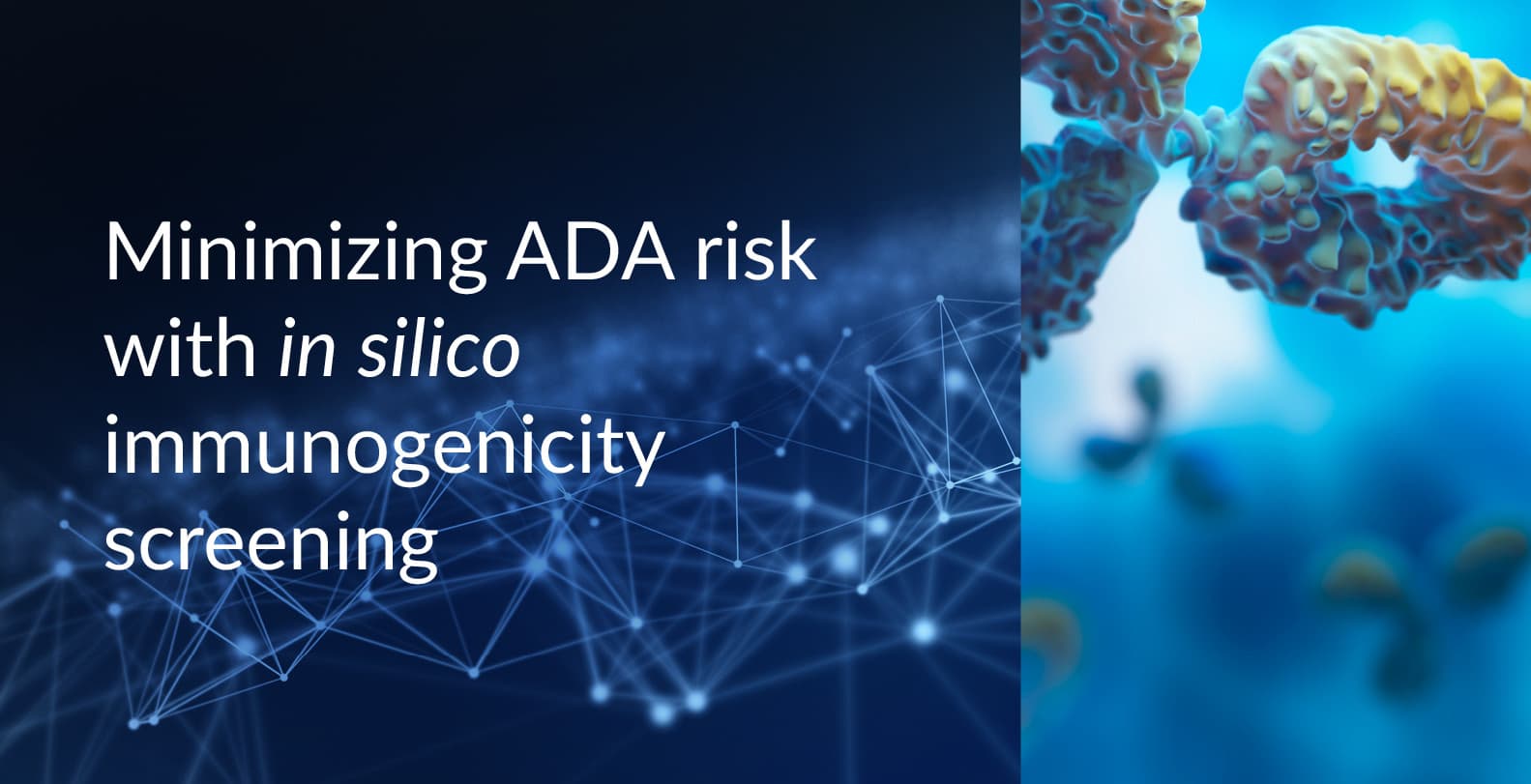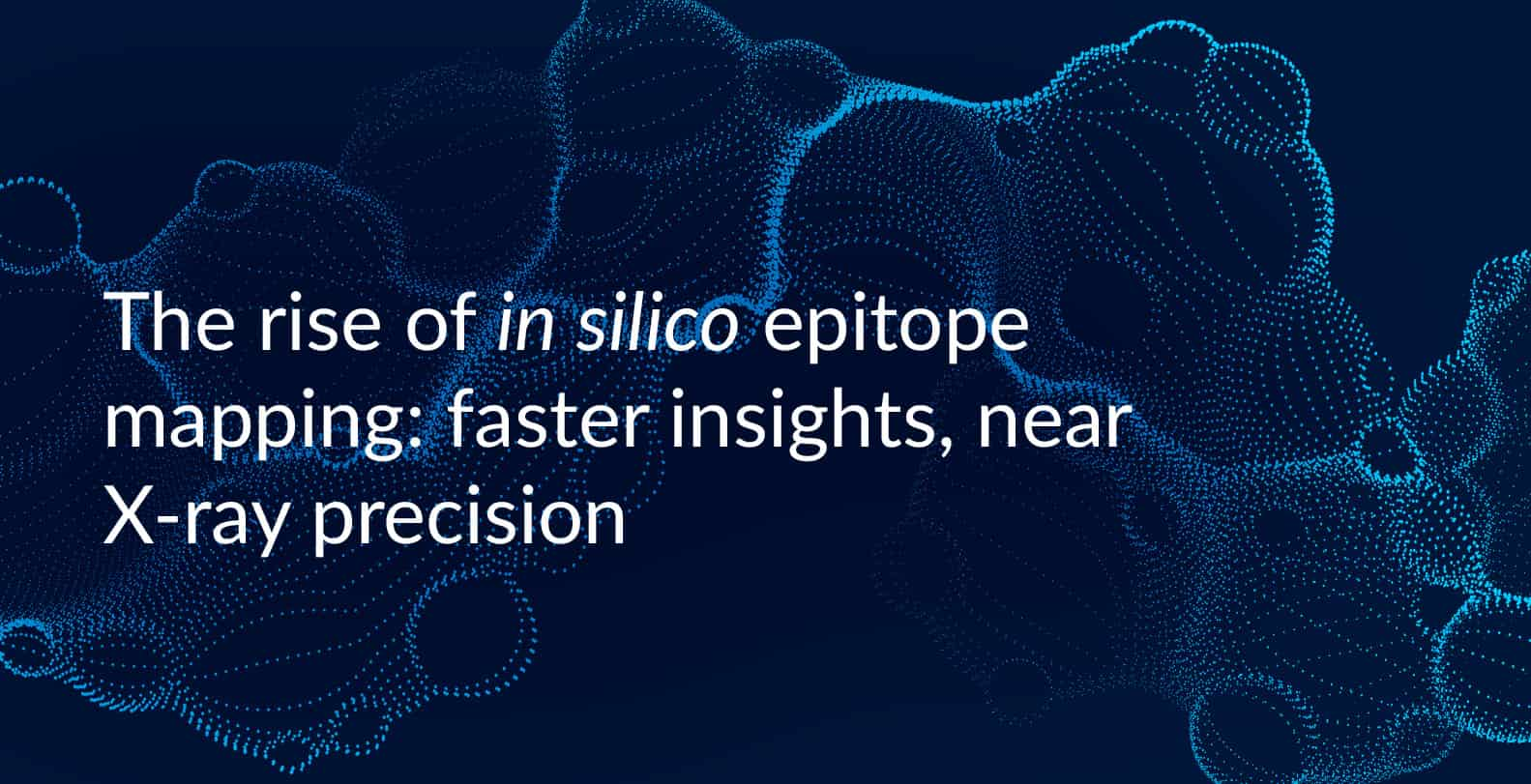Minimizing ADA risk with in silico immunogenicity screening

Audio version
Immunogenicity is a major cause of biologics failure, often identified too late in development. This blog explains how in silico screening helps detect anti-drug antibody (ADA) risks early, before costly setbacks. Learn how tools like LENSᵃⁱ™ enable faster, more informed decision-making by supporting early candidate evaluation, risk mitigation, and regulatory alignment.
The impact of immunogenicity in early biologics discovery
Immunogenicity remains one of the most important and often underappreciated factors in biologics development. For researchers and drug development teams working with monoclonal antibodies or therapeutic proteins, the risk of an unwanted immune response can derail even the most promising candidates.
The presence of anti-drug antibodies (ADAs) doesn’t always show up immediately. In many cases, the problem becomes evident only after significant investment of time and resources, often in later-stage trials. ADAs can reduce a drug’s effectiveness, alter its pharmacokinetics, or introduce safety risks that make regulatory approval unlikely. Some programs have even been discontinued because of immunogenicity-related findings that might have been identified much earlier.
To avoid these setbacks, teams are increasingly integrating predictive immunogenicity screening earlier in development. In silico tools now make it possible to evaluate ADA risk during the discovery stage, before resources are committed to high-risk candidates. This proactive approach supports smarter design decisions, reduces development delays, and helps safeguard against late-stage failure.
In this blog, we’ll explore how in silico immunogenicity screening offers a proactive way to detect potential ADA risks earlier in the pipeline. We’ll also look at how tools like BioStrand’s LENSai platform are helping to simplify and scale these assessments, making immunogenicity screening a practical part of modern biologics development.
Why early ADA risk assessment is critical
Immune responses to therapeutic proteins can derail even the most carefully designed drug candidates. When the immune system identifies a treatment as foreign, it may trigger the production of anti-drug antibodies (ADAs). These responses can alter how a drug is distributed in the body, reduce its therapeutic effect, or create safety concerns that weren't apparent during earlier studies. The consequences are often serious delays, added costs, program redesigns, or even full discontinuation.
This isn’t something to be considered only when a drug is close to clinical testing. It’s a risk that needs to be addressed from the beginning. Regulatory agencies increasingly expect sponsors to demonstrate that immunogenicity has been evaluated in early discovery, not just as a final check before filing. This shift reflects lessons learned from earlier products that failed late because they hadn't been properly screened.
Early-stage risk assessment allows developers to ask the right questions at the right time. Are there T-cell epitopes likely to trigger immune recognition? Is the candidate similar enough to self-proteins to escape detection? Could minor sequence changes reduce the chances of immunogenicity without compromising function?
Immunogenicity screening provides actionable insights that can guide sequence optimization well before preclinical testing. For example, identifying epitope clustering or T-cell activation hotspots during discovery enables teams to make targeted modifications in regions such as the variable domain. These adjustments can reduce immunogenicity risk without compromising target binding, helping streamline development and avoid costly rework later in the process.
Beyond candidate selection, immunogenicity screening improves resource allocation. If a molecule looks risky, there is no need to invest heavily in downstream testing until it has been optimized. It’s a smarter, more strategic way to manage timelines and reduce unnecessary costs.
The tools now available make this kind of assessment more accessible than ever. In silico screening platforms, powered by AI and machine learning, can run detailed analyses in a matter of hours. These insights help move projects forward without waiting for expensive and time-consuming lab work.
In short, assessing immunogenicity is not just about risk avoidance. It’s about building a better, faster path to clinical success.
In silico immunogenicity screening: How it works
In silico immunogenicity screening refers to the use of computational models to evaluate the immune risk profile of a biologic candidate. These methods allow development teams to simulate how the immune system might respond to a therapeutic protein, particularly by predicting T-cell epitopes that could trigger anti-drug antibody (ADA) formation.
The primary focus is often on identifying MHC class II binding peptides. These are the sequences most likely to be presented by antigen-presenting cells and recognized by helper T cells. If the immune system interprets these peptides as foreign, it can initiate a response that leads to ADA generation.
Unlike traditional in vitro methods, which may require weeks of experimental setup, in silico tools deliver results quickly and at scale. Developers can screen entire libraries of protein variants, comparing their immunogenicity profiles before any physical synthesis is done. This flexibility makes in silico screening particularly valuable in the discovery and preclinical stages, where multiple versions of a candidate might still be on the table.
The strength of this approach lies in its ability to deliver both breadth and depth. Algorithms trained on curated immunology datasets can evaluate binding affinity across a wide panel of human leukocyte antigen (HLA) alleles. They can also flag peptide clusters, overlapping epitopes, and areas where modifications may reduce risk. The result is a clearer picture of how a candidate will interact with immune pathways long before preclinical and clinical studies are initiated.
For teams juggling tight timelines and complex portfolios, these insights help drive smarter decision-making. High-risk sequences can be deprioritized or redesigned, while low-risk candidates can be advanced with greater confidence.
How LENSai supports predictive immunogenicity analysis
One platform leading the charge in this space is LENSai . Designed for early-stage R&D, it offers high-throughput analysis with a user-friendly interface, allowing computational biologists, immunologists, and drug developers to assess risks rapidly.
Here’s how LENSai supports smarter decision-making:
- Multi-faceted risk scoring: Rather than relying on a single predictor, LENSai integrates several immunogenicity markers into one unified score. This includes predicted MHC class II binding affinity across diverse HLA alleles, epitope clustering patterns, and peptide uniqueness compared to self-proteins based on proprietary HYFT technology. By combining these distinct factors, the platform provides insight into potential immune activation risk, supporting better-informed candidate selection.
- Reliable risk prediction: LENSai composite score reliably classifies candidates by ADA risk, using two thresholds to define low risk: <10% and <30% ADA risk. This distinction enables more confident go/no-go decisions in early development stages. By combining multiple features into a single score, the platform supports reproducible, interpretable risk assessment that is grounded in immunological relevance.
- Early-stage design support: LENSai is accessible from the earliest stages of drug design, without requiring lab inputs or complex configurations, designed for high-throughput screening of whole libraries of sequences in a few hours. Researchers can quickly assess sequence variants, compare immunogenicity profiles, and prioritize low-risk candidates before investing in downstream studies. This flexibility supports more efficient resource use and helps reduce the likelihood of late-stage surprises.
In a field where speed and accuracy both matter, this kind of screening helps bridge the gap between concept and clinic. It gives researchers the chance to make informed adjustments, rather than discovering late-stage liabilities when there is little room left to maneuver.
Case study: Validating ADA risk prediction with LENSai
In our recent case study, we applied LENSai’s Immunogenicity composite score to 217 therapeutic antibodies to evaluate predictive accuracy. For predicting ADA incidence >10%, the model achieves an AUC=0.79, indicating strong discriminative capability (AUC=0.8 is excellent). For predicting ADA incidence >30%, which is considered as more suitable for early-stage risk assessment purposes than the 10% cut-off, AUC rises to 0.92, confirming LENSai's value for ADA risk classification.
Read the full case study or contact us to discuss how this applies to your pipeline.
Regulatory perspectives: Immunogenicity is now a front-end issue
It wasn’t long ago that immunogenicity testing was seen as something to be done late in development. But regulators have since made it clear that immunogenicity risk must be considered much earlier. Agencies like the FDA and EMA now expect developers to proactively assess and mitigate immune responses well before clinical trials begin.
This shift came after a series of high-profile biologic failures where ADA responses were only discovered after significant time and money had already been spent. In some cases, the immune response not only reduced drug efficacy but also introduced safety concerns that delayed approval or halted development entirely.
Today, guidance documents explicitly encourage preclinical immunogenicity assessment. Sponsors are expected to show that they have evaluated candidate sequences, made risk-informed design choices, and taken steps to reduce immunogenic potential. In silico screening, particularly when combined with in vitro and in vivo data, provides a valuable layer of evidence in this process.
Early screening also supports a culture of quality by design. It enables teams to treat immunogenicity not as a regulatory hurdle, but as a standard consideration during candidate selection and development.
The regulatory landscape is shifting to support in silico innovation. In April 2025, the FDA took a major step by starting to phase out some animal testing requirements for antibody and drug development. Instead, developers are encouraged to use New Approach Methodologies (NAMs)—like AI models —to improve safety assessments and speed up time to clinic.
The role of in silico methods in modern biologics development
With the increasing complexity of therapeutic proteins and the diversity of patient populations, traditional testing methods are no longer enough. Drug development teams need scalable, predictive tools that can keep up with the speed of discovery and the demand for precision.
In silico immunogenicity screening is one of those tools. It has moved from being a theoretical exercise to a standard best practice in many organizations. Reducing dependence on reactive testing and allowing early optimization leads these methods to helping companies move forward with greater efficiency and lower risk.
When development teams have access to robust computational tools from the outset, the entire process tends to run more efficiently. These tools enable design flexibility, support earlier decision-making, and allow researchers to explore multiple design paths while maintaining alignment with regulatory expectations.
For companies managing multiple candidates across different therapeutic areas, this kind of foresight can translate to faster development, fewer setbacks, and ultimately, better outcomes for patients.
Final thoughts: From screening to smarter development
The promise of in silico immunogenicity screening lies in moving risk assessment to the earliest stages of development where it can have the greatest impact. By identifying high-risk sequences before synthesis, it helps researchers reduce late-stage failures, shorten timelines, lower overall project costs, and improve the likelihood of clinical success. In silico tools such as LENSai support the early prediction of ADA risk by flagging potential immunogenic regions and highlight risk patterns across diverse protein candidates, enabling earlier, more informed design decisions.
See how early ADA screening could strengthen your next candidate. Learn more.
Subscribe to our Blog and get new articles right after publication into your inbox.
Subscribe to our blog:







